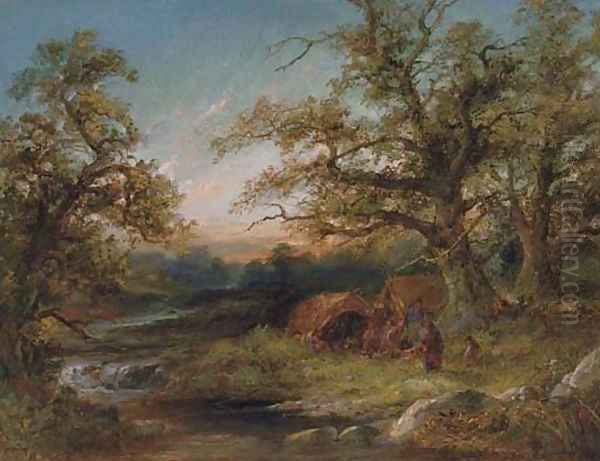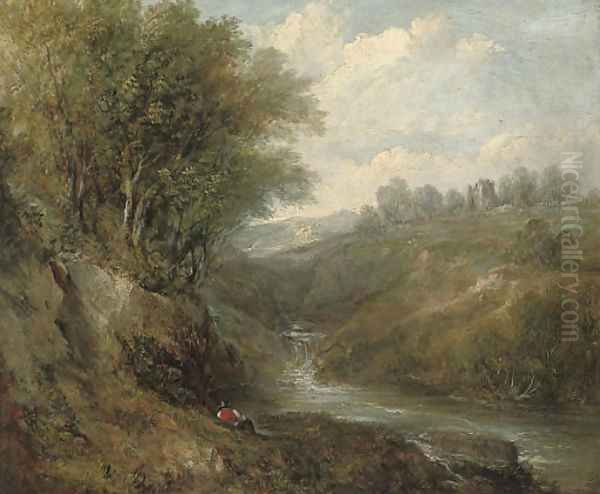
Frederick Henry Henshaw stands as a significant figure in the landscape of nineteenth-century British art, particularly associated with the vibrant artistic community of Birmingham during the Victorian era. Born in Birmingham on December 11, 1807, and passing away in 1891, Henshaw dedicated his long career primarily to the depiction of nature, earning renown for his evocative and detailed paintings of English forests, woodlands, and pastoral scenes. His work captures the particular sensibility of his time, blending careful observation with a romantic appreciation for the natural world, securing him a lasting place within the narrative of British landscape painting.
Early Life and Artistic Formation
Henshaw's artistic inclinations emerged early, nurtured within a supportive environment. His initial exposure to formal drawing techniques reportedly came indirectly, through studying copies his brothers made from lessons given by Samuel Lines (1778-1863), a foundational figure in Birmingham's art education. This early, perhaps unconventional, start highlights an innate drive towards visual representation. Henshaw received a more formal general education at the esteemed King Edward's School in Birmingham, a common path for boys of his background.
The pivotal moment in his artistic training arrived when he entered the studio of Joseph Vincent Barber (1788-1838). Barber was a highly respected landscape painter and drawing master in Birmingham, himself part of an artistic dynasty established by his father, Joseph Barber. Studying under J.V. Barber placed Henshaw within a direct lineage of the Birmingham school of landscape artists. It was here that he honed his skills in oil painting and watercolour, likely alongside other aspiring artists, including Thomas Creswick (1811-1869), who would also achieve considerable fame as a landscape painter. Barber's guidance undoubtedly shaped Henshaw's technique and his approach to capturing the nuances of the British countryside.
The Influence of Masters and Movements

While Joseph Vincent Barber provided Henshaw with his foundational training, the young artist's gaze also turned towards the giants of British landscape painting. He became a profound admirer of John Constable (1776-1837). Constable's revolutionary approach – his commitment to capturing the transient effects of light and weather, his focus on the familiar Suffolk countryside, and his use of expressive brushwork – resonated deeply with many artists of Henshaw's generation. While Henshaw developed his own distinct style, the influence of Constable's naturalism and his dedication to the specific character of the English landscape can be discerned in Henshaw's careful attention to detail and atmospheric effects.
Henshaw's career unfolded during the broader Victorian era, a period marked by diverse artistic trends. While not directly associated with the Pre-Raphaelite Brotherhood, founded in 1848, Henshaw worked during a time when their emphasis on truth to nature and meticulous detail influenced the general artistic climate. His own detailed rendering of foliage, bark, and geological formations aligns with the Victorian appreciation for scientific observation and intricate depiction. He operated within a tradition stretching back to earlier British landscape pioneers like Thomas Gainsborough (1727-1788) and Richard Wilson (1714-1782), and contemporary with the dramatic visions of J.M.W. Turner (1775-1851) and the established mastery of figures like David Cox (1783-1859), another artist strongly associated with Birmingham and landscape painting.
Developing a Signature Style
Frederick Henry Henshaw's artistic identity became firmly rooted in landscape painting, executed primarily in oils. His style is characterized by a detailed naturalism, a careful rendering of the textures and forms found in nature. He possessed a keen eye for the complexities of woodland interiors, capturing the play of sunlight filtering through leaves, the gnarled textures of ancient trees, and the damp richness of the forest floor. His compositions often balance intricate foreground detail with a sense of receding space, inviting the viewer into the scene.
His handling of light and shadow was particularly adept, contributing significantly to the mood and atmosphere of his paintings. Whether depicting the dappled sunlight of a summer afternoon or the softer, more diffused light of dawn or dusk, Henshaw used illumination to define form and evoke emotion. While grounded in observation, his work often carries a poetic quality, a gentle romanticism that celebrates the enduring beauty and tranquility of the natural world, perhaps offering a visual respite from the increasing industrialization of Victorian Britain. His palette typically favoured rich, earthy tones, appropriate for his chosen subject matter.
The Forest of Arden: A Defining Motif

Among Henshaw's most recurrent and celebrated subjects was the Forest of Arden in Warwickshire. This ancient woodland, imbued with historical and literary significance – most famously as the setting for Shakespeare's "As You Like It" – held a particular fascination for the artist. He returned to this theme repeatedly throughout his career, exploring its varied aspects in different seasons and times of day. His numerous depictions suggest a deep personal connection to this specific landscape.
Works such as The Old Forest Hall, Arden, Warwickshire (exhibited 1846) and The Entrance to the Forest, Arden, Warwickshire (exhibited 1848) exemplify his engagement with this motif. These paintings, along with others simply titled The Forest of Arden exhibited across many years (including 1845, 1847, 1849, 1850s, 1860s, 1870s, and up to 1880 with The Approach to the Forest of Arden), showcase his ability to capture both the grandeur and the intimacy of the forest. He depicted towering oaks, sunlit glades, winding paths, and occasionally introduced figures or rustic structures that enhanced the pastoral atmosphere. The Forest of Arden became almost synonymous with Henshaw's name, representing the quintessential English woodland landscape that he mastered.
Notable Works and Exhibitions
Beyond his extensive Forest of Arden series, Henshaw produced a diverse body of work showcasing his skill across various landscape subjects. An early success came in 1829 when he first exhibited at the prestigious Royal Academy of Arts in London. His submissions that year included Near Dolgellau and Valley near Crucorney Abbey, indicating an early interest in Welsh scenery, alongside Canal Bank - Moonlight and Bala Lake. These initial acceptances marked an important step in establishing his reputation beyond Birmingham.
He continued to exhibit regularly at the Royal Academy until 1864, contributing numerous views of English, Welsh, and occasionally continental European landscapes. Another notable work is The Bird's Nest, painted in 1862. This composition, featuring two boys discovering a nest on a wooded riverbank, combines landscape with a gentle narrative element typical of Victorian genre sensibilities. The painting A Gypsy Encampment further demonstrates his interest in incorporating human activity within natural settings, offering a glimpse into rural life and reflecting a common Victorian fascination with picturesque, sometimes romanticized, depictions of marginalized communities. His works consistently demonstrated technical proficiency and a deep sensitivity to his chosen environments.
Travels and Broadening Horizons
While Henshaw is primarily associated with the English Midlands, particularly Warwickshire, his artistic vision was broadened by travel. He undertook sketching tours not only within Britain, exploring regions like Wales, but also ventured further afield to the continent. Journeys to Germany, Switzerland, and Italy exposed him to different types of landscapes, from the Rhine Valley to the Alps and the Italian countryside. He also travelled to Ireland.
These expeditions provided fresh subject matter and likely influenced his understanding of light and topography. Although finished oil paintings based on these travels might be less numerous than his English scenes, the sketches and studies made en plein air would have enriched his visual vocabulary and technical repertoire. This practice of travelling to sketch was common among landscape artists of the period, including contemporaries like Samuel Prout (1783-1852) and William James Müller (1812-1845), allowing them to gather diverse material for later studio work. For Henshaw, these experiences reinforced his skills in observation and composition, even as he remained most devoted to the landscapes closer to home.
Role in the Birmingham Art Scene
Frederick Henry Henshaw was not merely a painter working in isolation; he was an active participant in the burgeoning art world of his native Birmingham. He was one of the founding members of the Birmingham Society of Artists (BSA) in 1826. This society played a crucial role in promoting art and artists in the region, organizing exhibitions and fostering a sense of community among local practitioners. It later received a Royal charter, becoming the Royal Birmingham Society of Artists (RBSA), an institution that continues to thrive today.
His involvement with the BSA from its inception underscores his commitment to the local art scene. He exhibited frequently in the society's exhibitions throughout his career, providing a platform for his work alongside fellow Birmingham artists like his former teacher J.V. Barber, Samuel Lines, David Cox, and others. His consistent presence and the quality of his contributions helped to elevate the standard and reputation of the Birmingham school of landscape painting. After 1864, he moved to Small Heath, then a developing suburb of Birmingham, but remained connected to the city's artistic life.
Later Life and Continued Practice
Henshaw enjoyed a long and productive career, continuing to paint and exhibit well into his later years. His move to Small Heath around 1864 coincided with the cessation of his regular submissions to the London Royal Academy, perhaps indicating a shift towards focusing more exclusively on the Birmingham art market and his established network of patrons there. However, his artistic output did not diminish significantly.
He remained a respected elder figure in the Birmingham art community. His dedication to landscape painting persisted, and he continued to explore his favoured themes, particularly the woodland scenery that had become his hallmark. His later works likely reflected the accumulated experience and refinement of technique gathered over decades of practice. He passed away in 1891 at the age of 83 or 84, leaving behind a substantial body of work that documented the landscapes he loved and contributed significantly to the artistic heritage of his region.
Contemporaries and Collaborations
Henshaw's artistic journey intersected with numerous other artists. His primary mentor was Joseph Vincent Barber, and he studied alongside Thomas Creswick. His admiration for John Constable was a significant, albeit indirect, connection. There is speculation, though unconfirmed, that he might have received some instruction from the celebrated watercolourist and oil painter David Cox, another major figure associated with Birmingham.
An interesting and more direct connection existed with Robert John Hammond (fl. 1848-1881). Although Hammond lacked formal training, records indicate that he and Henshaw collaborated on works and shared living quarters for a time. This suggests a close personal and professional relationship, though the exact nature of their artistic collaboration warrants further investigation. Henshaw's participation in the Birmingham Society of Artists naturally brought him into contact with the wider circle of Midland artists. His work can be situated alongside other Victorian landscape painters who focused on detailed depictions of the British countryside, such as Benjamin Williams Leader (1831-1923) and Myles Birket Foster (1825-1899), although Henshaw's style retained its own distinct character rooted in the earlier generation of Barber and Constable.
Legacy and Critical Reception
Frederick Henry Henshaw is remembered today primarily as a leading figure of the Birmingham school of landscape painters during the Victorian era. His reputation rests on his skillful and sensitive depictions of English, particularly Midland, scenery, with a special emphasis on woodland interiors. While he may not have achieved the national or international fame of contemporaries like Turner or Constable, his contribution to British landscape painting, especially within its regional context, is undeniable.
Academic assessment acknowledges his technical skill, his fine draughtsmanship, and his ability to capture atmospheric effects. His work is seen as embodying many key characteristics of Victorian landscape art: a commitment to naturalistic detail, a romantic sensibility towards nature, and often a quiet, pastoral mood. His influence was felt most strongly within the Birmingham art scene, where he served as both an accomplished practitioner and an active member of its core institution, the RBSA.
His legacy is preserved through his paintings, which are held in significant public collections, including the Birmingham Museum & Art Gallery (which holds a substantial collection of his work), Sheffield Galleries, York Art Gallery, and the National Trust. These works continue to be appreciated for their artistic merit and as valuable records of the nineteenth-century British landscape, reflecting a deep love for the natural world that resonated with Henshaw and his Victorian audience.
Conclusion
Frederick Henry Henshaw carved a distinct niche for himself within the rich tapestry of 19th-century British art. As a dedicated landscape painter, he excelled in capturing the intricate beauty and serene atmosphere of the English countryside, particularly the woodlands of the Midlands. Mentored by Joseph Vincent Barber and inspired by John Constable, he developed a style characterized by detailed naturalism and a sensitive handling of light. His lifelong association with the Forest of Arden produced a remarkable series of works that stand as his most iconic contribution. An active participant in the Birmingham art scene and a founding member of its Society of Artists, Henshaw played a significant role in the cultural life of his native city. Though perhaps overshadowed on the national stage by more revolutionary figures, his substantial body of work, preserved in numerous public collections, remains a testament to his skill, dedication, and enduring affection for the landscapes he so meticulously chronicled.